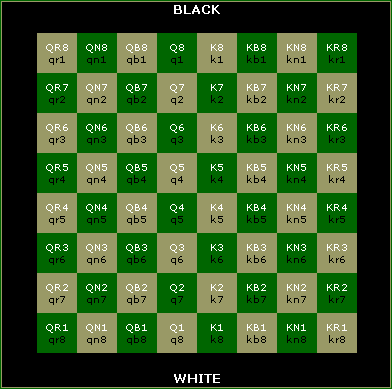
Games published using figurine notation can be understood by anyone in any language. The move 'e4' means that a Pawn is moving to the square e4.įigurine notation is a variant of algebraic notation where symbols are used to identify the piece being moved. By convention, the letter for the Pawn is always omitted. The move 'Qe4' means that a Queen is moving to the square e4.
CHESS PIECE MOVES KEY PLUS
The letters are self-explanatory, except for the Knight, where 'N' avoids confusion with the King.Ī move is a combination of the moving piece plus the square to which it is moving. The pieces are identified by a single letter - 'P' for Pawn, 'N' for Knight, 'R' for Rook, 'B' for Bishop, 'Q' for Queen, and 'K' for King. Note that the board is usually displayed with White at the bottom and Black at the top. The square in the lower left is 'a1', while the square in the upper right is 'h8'. Here's a diagram showing the two character notation for each square on the board. The square at the intersection of a column and a row is identified by the letter for the column and the number for the row. For the columns of the board it uses the letters 'a' through 'h', left to right from the White side. For the rows of the chess board it assigns the numbers '1' through '8' starting from the White side. RI.12.10 - By the end of grade 12, read and comprehend literary nonfiction at the high end of the grades 11–CCR text complexity band independently and proficiently.Notation is the key to publishing chess games.Ĭhess notation gives us the means to record chess games, to publish them, and to discuss specific positions on the chess board.Īlgebraic notation is the most common notation in use. RI.11.10 - By the end of grade 11, read and comprehend literary nonfiction in the grades 11–CCR text complexity band proficiently, with scaffolding as needed at the high end of the range. RI.10.10 - By the end of grade 10, read and comprehend literary nonfiction at the high end of the grades 9–10 text complexity band independently and proficiently. RI.9.10 - By the end of grade 9, read and comprehend literary nonfiction in the grades 9–10 text complexity band proficiently, with scaffolding as needed at the high end of the range. RI.8.10 - By the end of the year, read and comprehend literary nonfiction at the high end of the grades 6–8 text complexity band independently and proficiently. RI.7.10 - By the end of the year, read and comprehend literary nonfiction in the grades 6–8 text complexity band proficiently, with scaffolding as needed at the high end of the range.

RI.6.10 - By the end of the year, read and comprehend literary nonfiction in the grades 6–8 text complexity band proficiently, with scaffolding as needed at the high end of the range. RI.5.10 - By the end of the year, read and comprehend informational texts, including history/social studies, science, and technical texts, at the high end of the grades 4–5 text complexity band independently and proficiently.

RI.4.10 - By the end of year, read and comprehend informational texts, including history/social studies, science, and technical texts, in the grades 4–5 text complexity band proficiently, with scaffolding as needed at the high end of the range. RI.3.10 - By the end of the year, read and comprehend informational texts, including history/social studies, science, and technical texts, at the high end of the grades 2–3 text complexity band independently and proficiently.

RI.2.10 - By the end of year, read and comprehend informational texts, including history/social studies, science, and technical texts, in the grades 2–3 text complexity band proficiently, with scaffolding as needed at the high end of the range. RI.1.10 - With prompting and support, read informational texts appropriately complex for grade 1.

RI.K.10 - Actively engage in group reading activities with purpose and understanding.


 0 kommentar(er)
0 kommentar(er)
